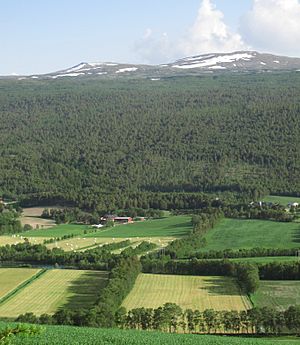Windbreak facts for kids
A windbreak (also called a shelterbelt) is a group of trees or shrubs planted in rows. They are placed to block strong winds and protect the soil from being blown away. You often see them as hedges around farm fields.
Windbreaks can help save energy at home by reducing heating and cooling costs. They also stop snow from piling up on roads or in yards. Farmers sometimes use them to keep snow on their land, which provides water when it melts in spring. Windbreaks also create a special mini-climate for crops, making them less likely to dry out or get too cold at night. They provide homes for wildlife and, in some places, can be a source of wood.
Farmers can combine windbreaks with planting different crops in rows, a method called alleycropping. Here, rows of trees are planted between rows of crops. The trees can provide fruit or wood, and they protect the crops from wind. This method has worked well in places like India, Africa, and Brazil, especially for coffee growers.
Another use for windbreaks is to hide a farm from busy roads or highways. This makes the farm look nicer, reduces noise from traffic, and creates a safe barrier between farm animals and the road.
There are also fences called "windbreaks." These are usually made from strong fabrics like cotton or nylon. They have panels held up by poles that are pushed into the ground. These fences help slow down wind over open fields or dusty industrial areas. Slowing the wind by half can reduce soil erosion by a lot!
Areas that are calm and windless because of a windbreak are called wind shadows.
How Windbreaks Work
When wind hits a windbreak, the air pressure changes. It builds up on the side facing the wind and drops on the other side. Some of the wind goes over the top, speeding up for a moment. The rest of the wind pushes through the trees.
As the wind comes out the other side, it slows down a lot. The slowest wind speed is usually found about 3 to 5 times the height of the windbreak away from it. After that, the wind starts to speed up again. The leaves and branches of the trees create drag, which is like a brake for the wind.
This slowing down of the wind also changes the area around the windbreak. For example, the ground might stay warmer because the slower wind doesn't carry heat away as quickly.
Famous Windbreak Projects
- The Great Plains Shelterbelt was a huge project in the USA during the 1930s. This was a time called the "Dust Bowl," when strong winds blew away a lot of soil. The project planted many shelterbelts across the prairies to stop this erosion.
- In Canada, the Prairie Farm Rehabilitation Administration helped farmers for almost 100 years. They taught farmers about windbreaks and gave them young trees to plant. This helped reduce soil erosion and made life better on the prairies.
- Today, TreeTime.ca is a big supplier of young trees for shelterbelts in Canada.
Images for kids
-
Aerial view of field windbreaks in North Dakota
-
One of the original buildings at Svappavaara, designed by Ralph Erskine, which forms a long windbreak





